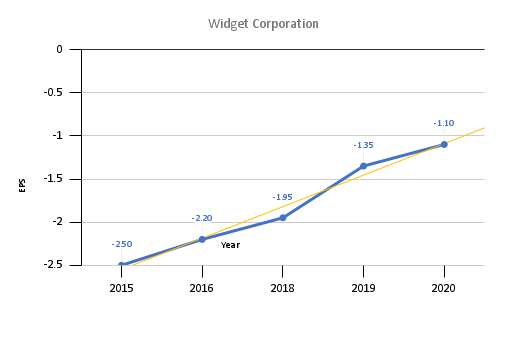However, traditional fundamental analysis won’t work with these types of stocks. Instead, investors must use different metrics and valuation tools to perform their due diligence and determine the intrinsic value for the stock’s price.
Be sure to check our Portfolio Management Channel to learn more about different portfolio rebalancing strategies.
How to Make the Adjustment for Negative Earnings
A stock that reports a net loss will have negative earnings, rendering traditional P/E analysis incompatible. But there are several methods you can use to determine how much a stock is worth without using a P/E ratio. Investors should note that one of the most common methods used by professional analysts is not covered here – discounted cash flows (DCF). The complexity of this type of analytical valuation and the requirement of precise growth estimates makes this a challenging task for the everyday trader.
Enterprise Value to EBITDA
When investors use this type of valuation method, they are determining a multiple for a company’s EBITDA (Earnings Before Interest, Taxes, Depreciation, and Amortization) and comparing it to its Enterprise Value (EV) – a simple metric that is just equity plus debt, minus cash holdings.
For example, let’s say the Widget Corporation shows EBITDA of $25 million for 2020. When you compare the EV-to-EBITDA ratio of similar companies, you get an average multiple of 12. By multiplying this figure by the EBITDA of $25 million, you can figure out that the Widget Corporation has an EV of $300 million. By looking at the company’s financials, you can see they have $30 million in debt, $5 million in cash holdings, and 50 million shares outstanding. That gives the company an equity value of $275 million, or $5.50 per share.
Alternative P/E
One of the simplest methods to determine a stock’s value is to look at the company’s past earnings track record. Projecting future earnings by establishing how a company’s EPS has changed over time is still usable even if those earnings are currently negative.
Obtaining several data points can help you build a model of its growth over time.
Let’s take a look at a hypothetical example to see how this works.

The projected EPS growth rate is the key metric we are looking for in this kind of stock. When the company is projected to be net positive is one primary driver for determining the valuation multiple for the stock price – the quicker it reaches that goal, the higher the premium investors are willing to pay. In the case of our fictional Widget Corporation, the trendline indicates the stock will be in the black by 2023, assuming the growth rate stays on track.
Alternatively, you can find a traditional valuation metric, such as the price-to-sales ratio that applies to both positive and negative earning companies. Looking at comparable P/S ratios can give you an idea of how the negatively earning stock is currently being priced relative to its peers. This can give you a broad idea of whether the stock is potentially over- or undervalued.
Make sure to check our Screener to make sure you are picking the right security for your portfolio. You can also select securities that are rated high on our proprietary Dividend Safety rating system.
Considerations to Keep in Mind
If the stock pays out a dividend, you should be doubly cautious. Dividends are doled out to investors in lieu of investing back into the company, which could indicate a troubled outlook for the company. An unsustainable dividend payout means the company will need to cut it to free up more income to make debt payments or investments back into the business.
Certain industries tend to have more stocks with negative earnings than others. For instance, biotech companies don’t see a profit on a new drug until it has passed multiple FDA phase testing, which can take years. It’s common for these companies to stay in the red for a prolonged period of time before suddenly making a leap to profitability.
One last consideration is more of a qualitative analysis rather than quantitative. It’s important to take note of what kind of business the company does, who its main competitors are, and the market outlook for the company’s products or services.
The Bottom Line
Understanding how to properly analyze and value a stock that hasn’t become profitable yet will give you a wider selection of potential stock picks for your portfolio and help keep your profits steadily in the black.
Make sure to visit our News section to catch up with the latest news about income investing.

